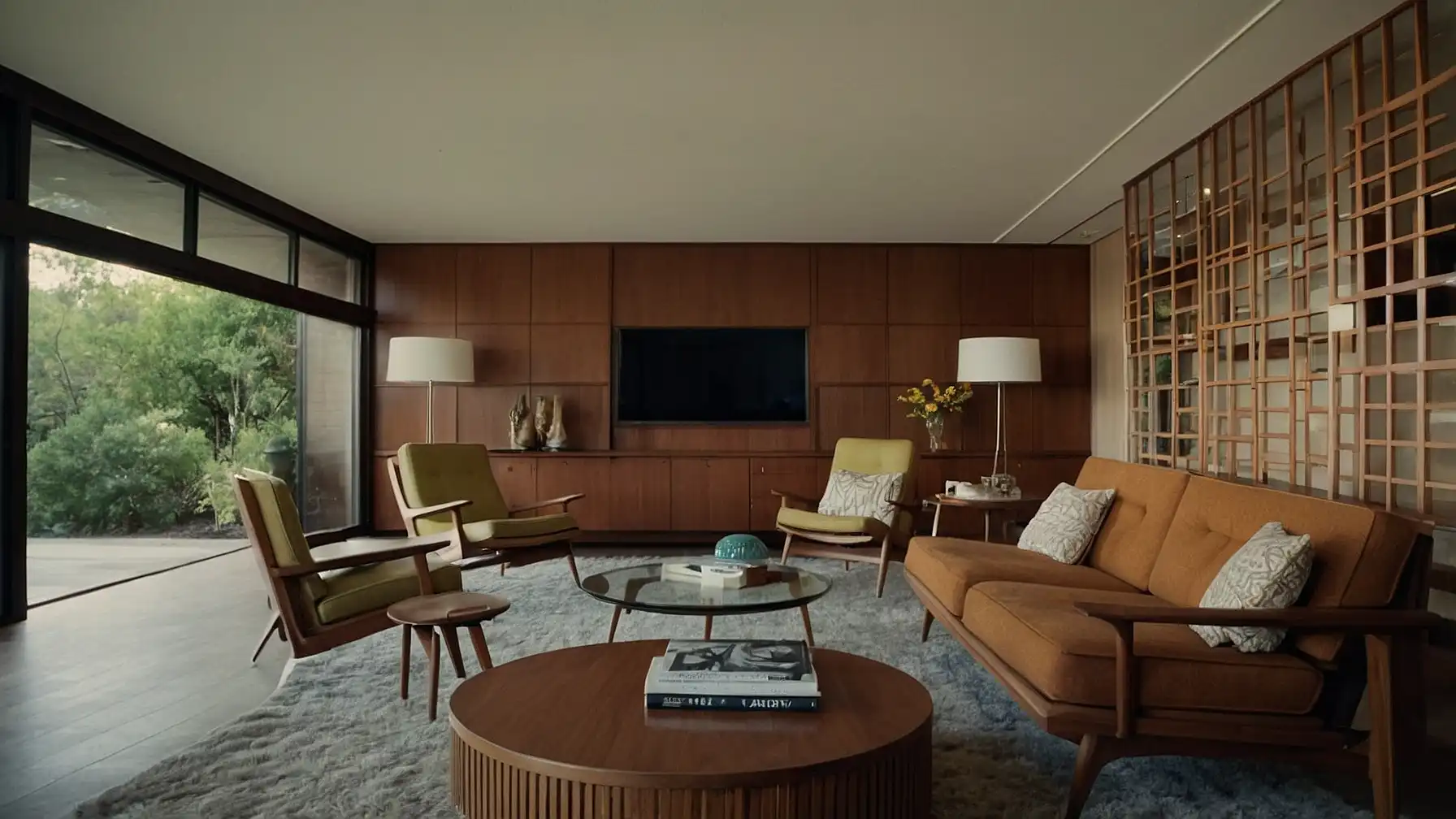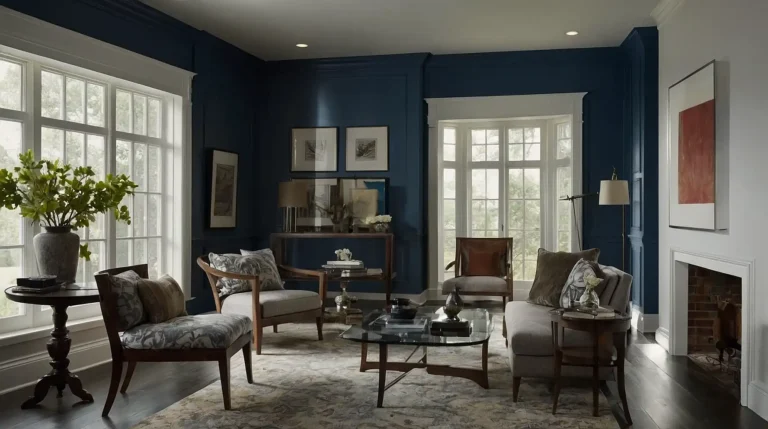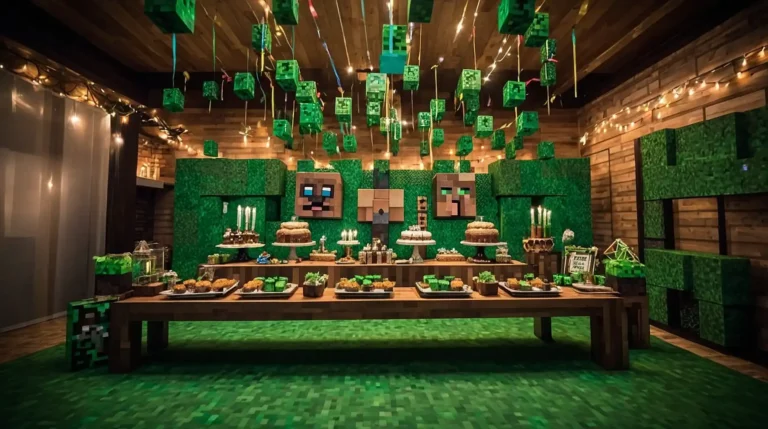27 Midcentury Modern Living Room Ideas
Midcentury modern design brings timeless sophistication to contemporary living rooms.
This iconic style emphasizes clean lines, natural materials, and functional beauty that feels fresh today.
You can achieve authentic midcentury appeal through furniture, colors, and architectural details.
The aesthetic celebrates both form and function in perfectly balanced harmony.
These ideas create spaces that honor design history while meeting modern needs.
1: Low-Profile Sectional Sofas

Choose sleek, low-sitting sectionals with thin legs and minimal arms for authentic midcentury appeal.
You create open, airy feeling while providing comfortable seating for family gatherings.
Look for pieces in neutral tones like charcoal, camel, or cream colors. The horizontal emphasis makes rooms feel larger while maintaining sophisticated style.
Your low-profile seating establishes the foundation for midcentury modern living rooms.
2: Walnut Wood Coffee Tables
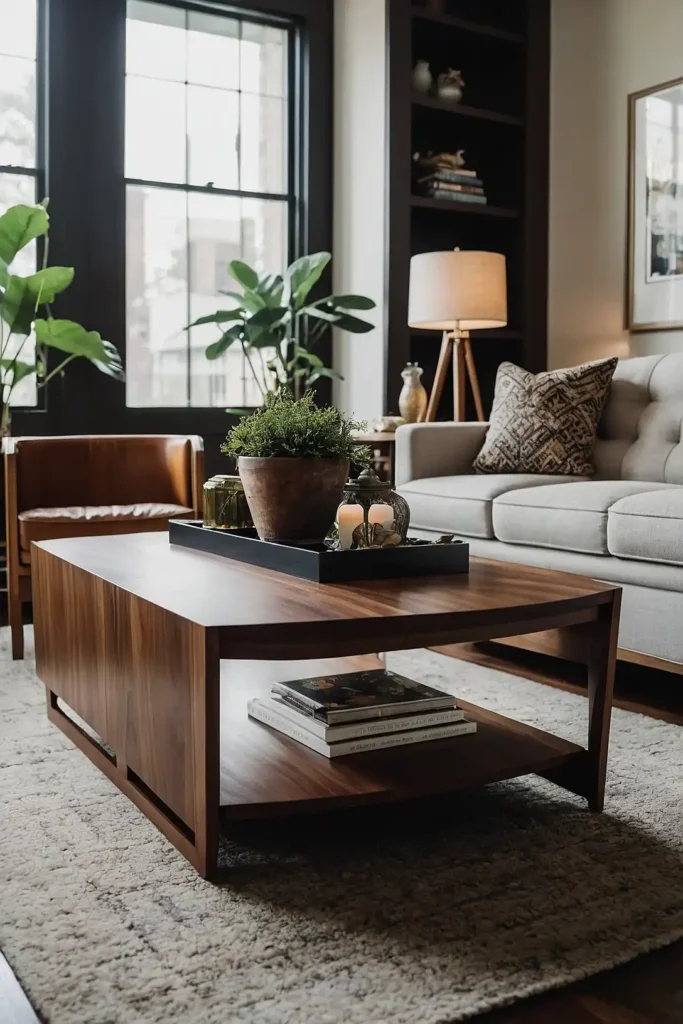
Select coffee tables featuring rich walnut wood with distinctive grain patterns and organic shapes.
You add natural warmth while showcasing the era’s love for beautiful materials.
Choose pieces with hairpin legs, boomerang shapes, or kidney forms for authenticity.
The warm wood tones ground neutral color schemes while adding visual interest.
Your walnut table becomes a stunning centerpiece that defines midcentury elegance.
3: Iconic Eames Lounge Chair
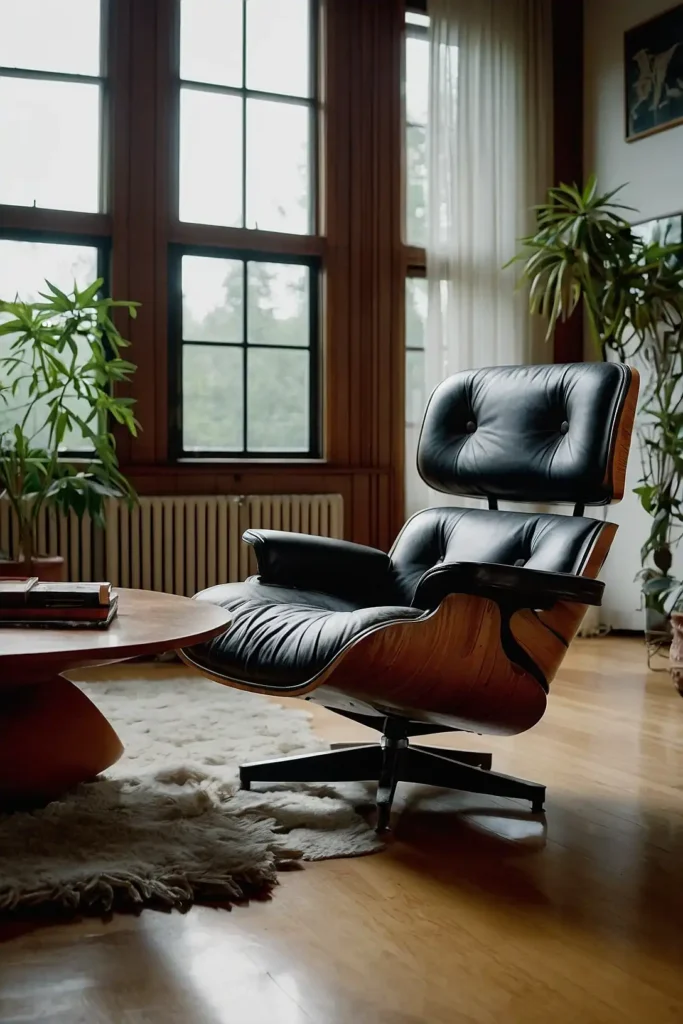
Invest in an Eames lounge chair and ottoman for the ultimate midcentury statement piece.
You bring design history into your living room while adding luxurious comfort.
The molded plywood and leather combination exemplifies the era’s innovative materials and techniques.
Position the chair to create a dedicated reading or conversation area.
Your Eames chair becomes both functional seating and sculptural art simultaneously.
4: Bold Geometric Area Rugs

Layer geometric rugs featuring atomic patterns, diamonds, or abstract shapes in vibrant colors.
You add visual interest while defining seating areas and adding midcentury pattern vocabulary.
Choose rugs with orange, turquoise, or mustard accents against neutral backgrounds.
The patterns should complement rather than compete with furniture and artwork.
Your geometric rug anchors the room while introducing authentic midcentury design elements.
5: Floor-to-Ceiling Windows
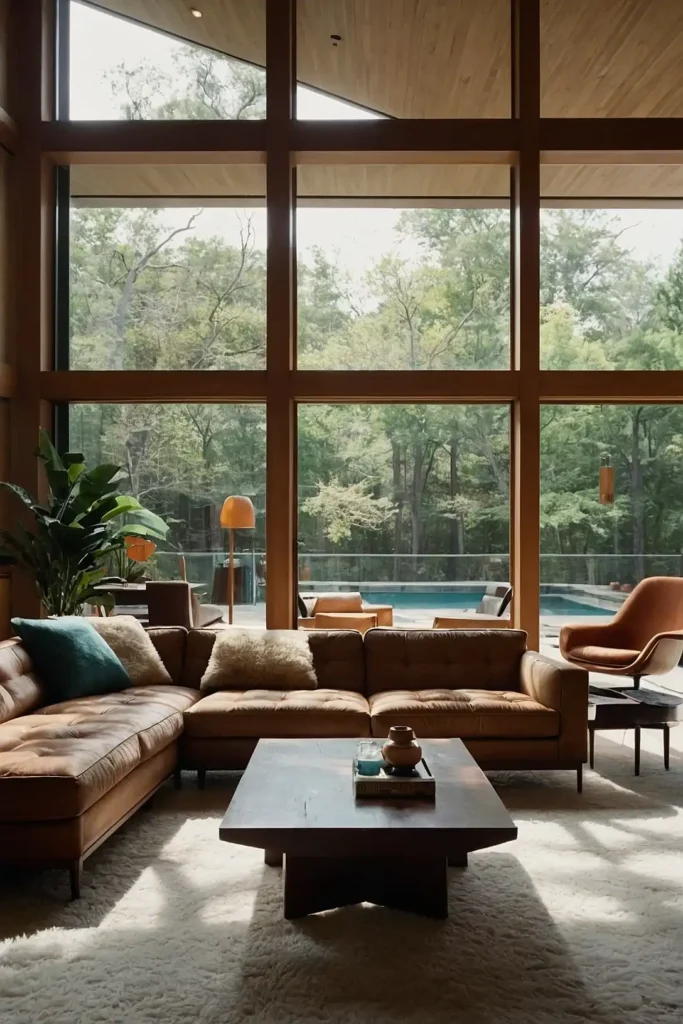
Maximize natural light with large windows that blur indoor-outdoor boundaries characteristic of midcentury architecture.
You create bright, airy spaces that connect with nature.
Keep window treatments minimal with simple panels or no coverings at all.
The abundant natural light highlights furniture and creates dynamic shadows throughout the day.
Your expansive windows become architectural features that define midcentury modern aesthetics.
6: Teak Storage Credenzas
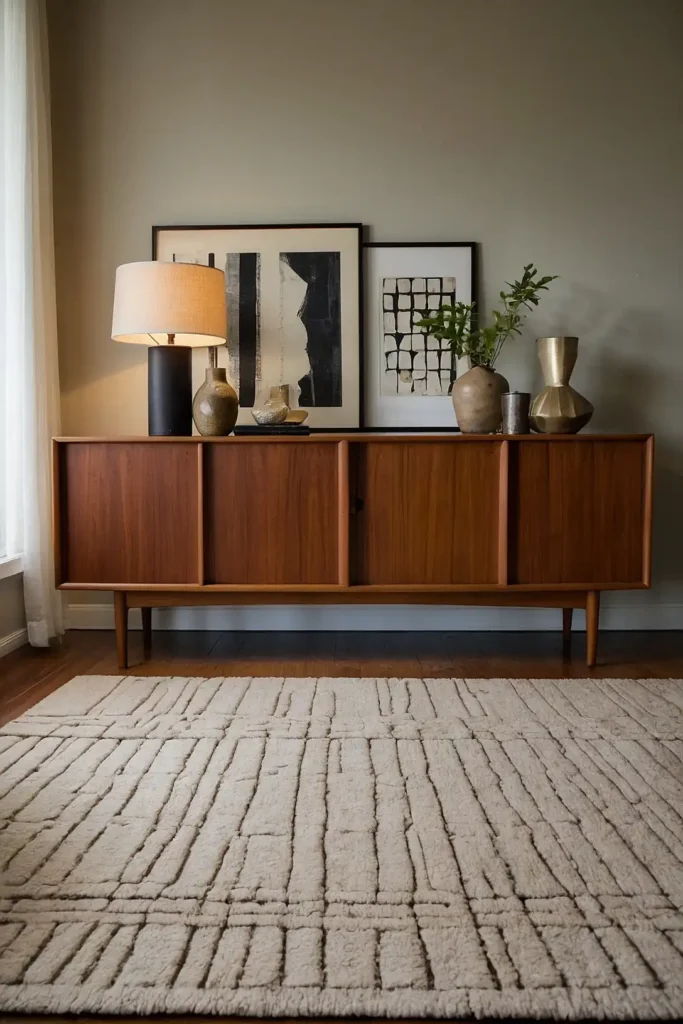
Install low teak credenzas for media storage, bar areas, or display space.
You add authentic midcentury storage while showcasing the era’s excellent craftsmanship.
Look for pieces with sliding doors, tapered legs, and brass hardware details.
The horizontal lines complement low-profile furniture while providing practical storage solutions.
Your teak credenza combines beautiful design with essential living room functionality.
7: Atomic-Era Lighting Fixtures
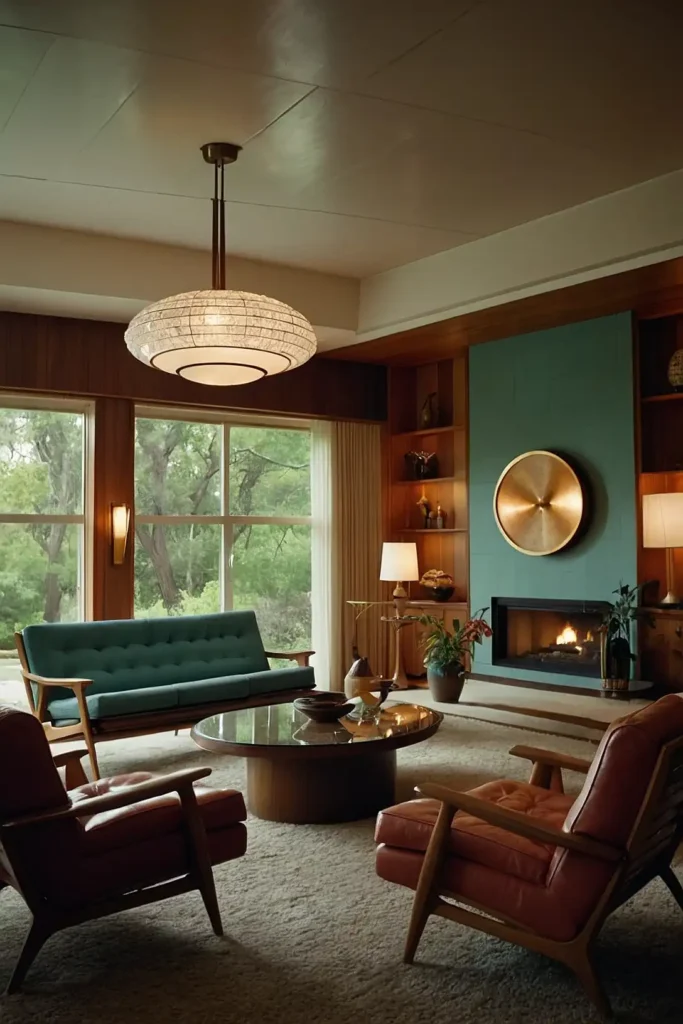
Choose pendant lights, floor lamps, or chandeliers featuring starburst, atomic, or geometric designs.
You illuminate spaces while adding sculptural elements that define the era.
Brass, copper, and black finishes work best with midcentury color palettes. Position lighting to highlight artwork and create ambient evening atmospheres.
Your atomic lighting becomes both functional illumination and decorative focal points.
8: Warm Earth Tone Palettes
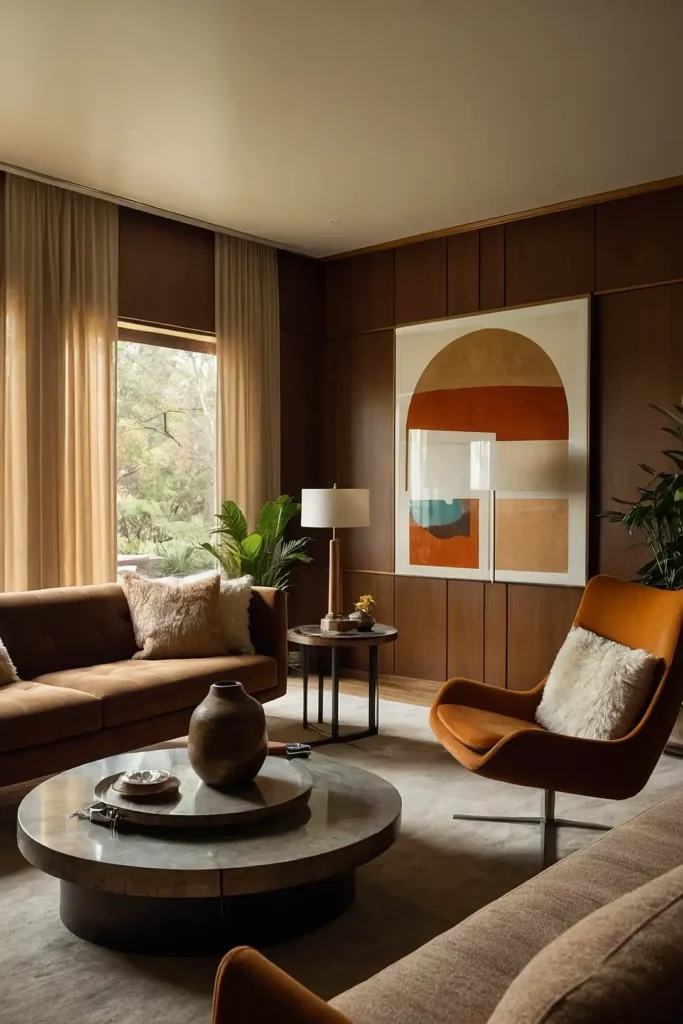
Develop color schemes using ochre, burnt orange, avocado green, and warm browns.
You create inviting atmospheres that reflect the era’s connection to natural colors.
Balance bold accent colors with neutral backgrounds for sophisticated results.
This palette works especially well with natural wood and brass accents.
Your earth-tone scheme creates cozy sophistication that feels both retro and timeless.
9: Built-In Shelving Systems

Install floor-to-ceiling shelving units with clean lines and minimal hardware for authentic storage.
You create display space while maintaining the era’s emphasis on built-in solutions.
Mix open shelves with closed cabinets for visual variety and practical storage.
Use shelving to display books, ceramics, and decorative objects thoughtfully.
Your built-in storage becomes architectural features that enhance midcentury modern interiors.
10: Abstract Art Collections

Display large-scale abstract paintings or prints featuring bold colors and geometric forms.
You add artistic sophistication while celebrating the era’s love for contemporary art.
Choose pieces that complement your color scheme without matching exactly for sophisticated appeal.
Group smaller works together for gallery wall effects.
Your abstract art becomes focal points that express midcentury modern cultural values.
11: Brass and Copper Accents
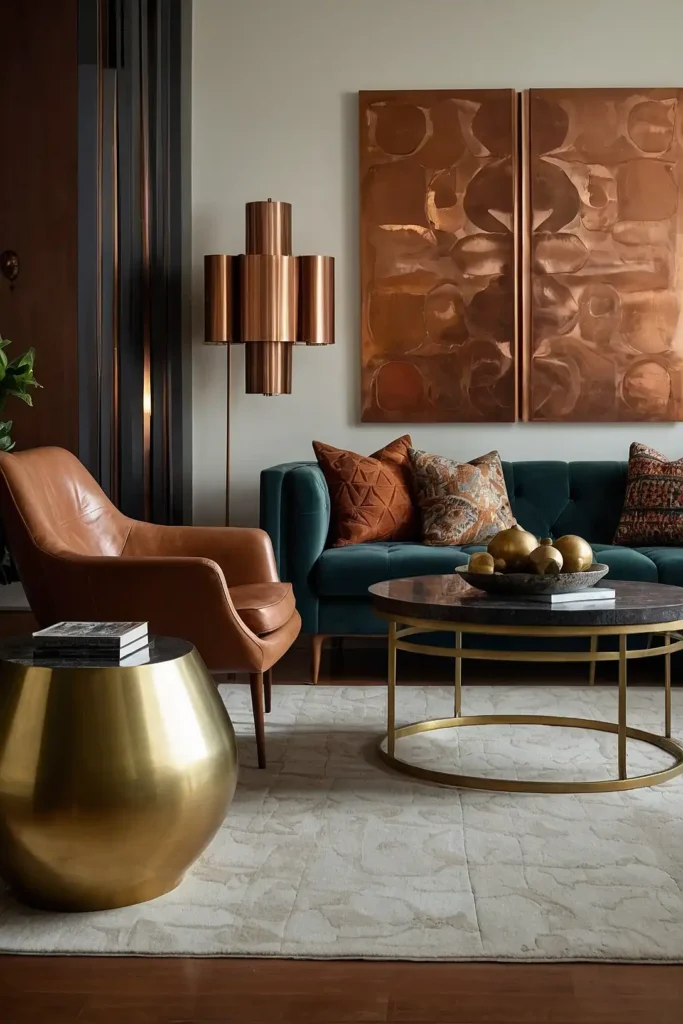
Incorporate warm metal finishes through lighting, hardware, and decorative accessories throughout rooms.
You add luxury and warmth while honoring midcentury material preferences.
Mix brass table lamps, copper planters, and gold-toned picture frames for layered metallics.
The warm tones complement wood furniture and earth-tone color schemes.
Your metal accents bring sophistication and historical authenticity to modern spaces.
12: Kidney-Shaped Side Tables
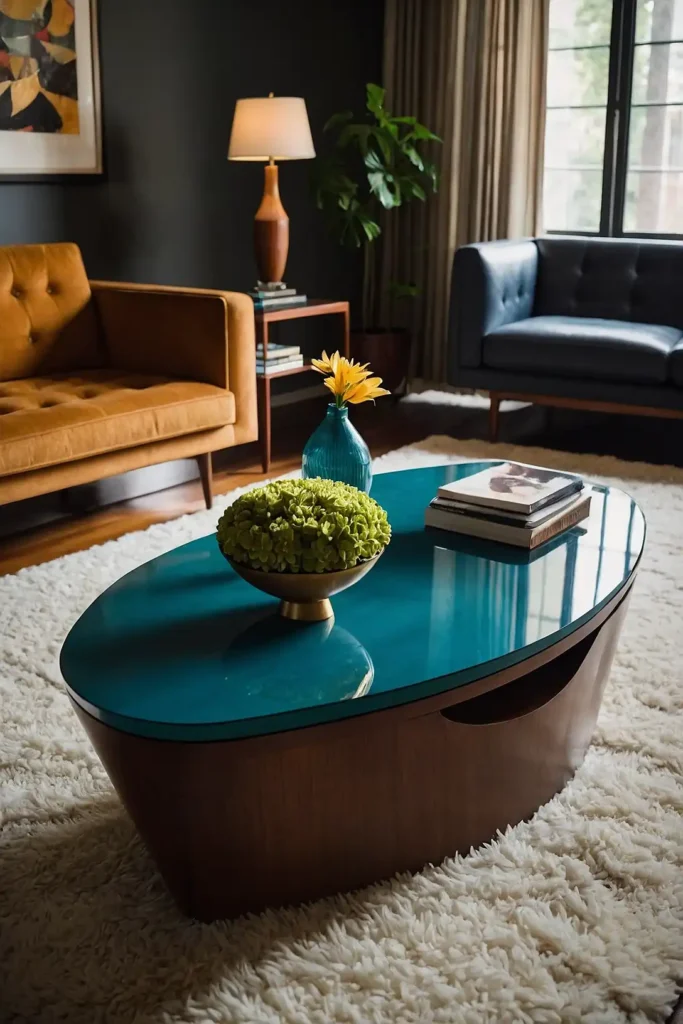
Choose organic, curved side tables that contrast with angular sofa and chair lines.
You add visual interest while showcasing the era’s embrace of biomorphic forms.
Position these sculptural pieces beside seating areas for both function and style.
The flowing shapes soften geometric furniture arrangements while maintaining sophisticated appeal.
Your curved tables demonstrate midcentury design’s balance between organic and geometric forms.
13: Open Floor Plan Layouts
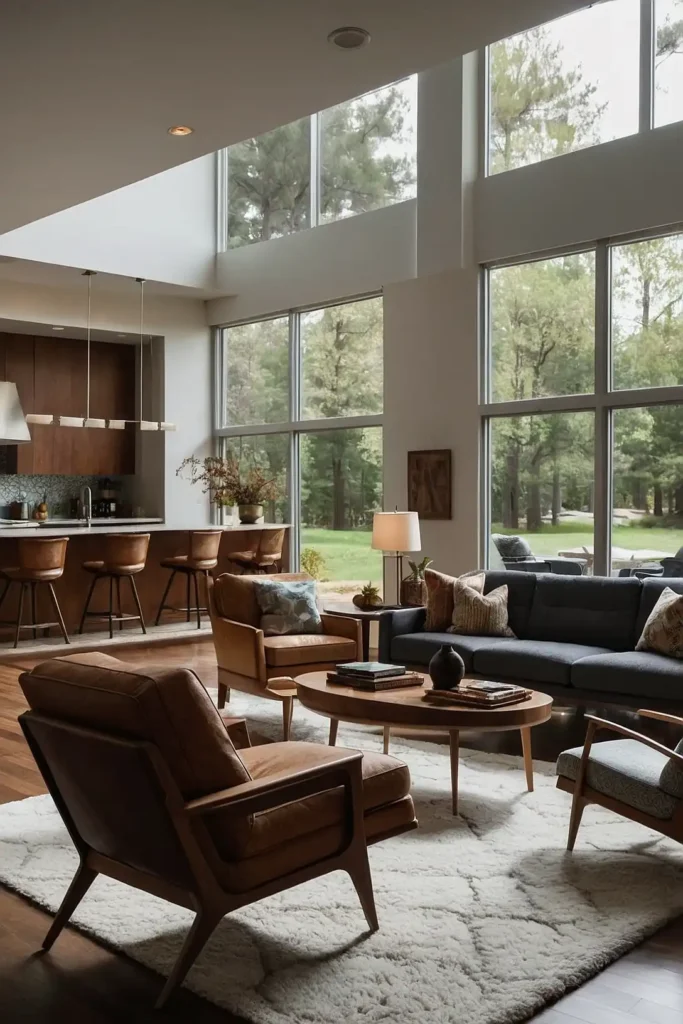
Arrange furniture to create flowing, open spaces that eliminate unnecessary barriers between areas.
You achieve the era’s emphasis on informal, flexible living arrangements.
Float furniture away from walls to define conversation areas without blocking sightlines.
This approach makes rooms feel larger while encouraging social interaction.
Your open layout reflects midcentury values of casual, modern family living.
14: Natural Stone Accent Walls

Install stacked stone or brick accent walls that bring texture and natural materials indoors.
You add architectural interest while connecting to the era’s material honesty.
Choose stones in neutral colors that complement wood and metal finishes throughout rooms.
The textural contrast enhances smooth, sleek furniture and accessories.
Your stone wall becomes a dramatic backdrop for midcentury modern furnishings.
15: Boomerang Coffee Table Shapes

Select coffee tables featuring the iconic boomerang or hourglass silhouette popular during the era.
You add authentic midcentury style while providing functional surface space.
The distinctive shape works well with both angular and curved seating arrangements.
Choose pieces in walnut, teak, or glass to complement your overall design scheme.
Your boomerang table becomes a conversation piece that anchors seating areas beautifully.
16: Large Indoor Plants

Include substantial plants like fiddle leaf figs, monstera, or rubber trees for natural elements.
You bring life and color while honoring the era’s love for biophilic design.
Position plants in ceramic or brass planters that complement your color scheme.
The organic shapes and textures soften hard-lined furniture and architectural elements.
Your plants add vitality while connecting indoor spaces to natural environments.
17: Hairpin Leg Furniture
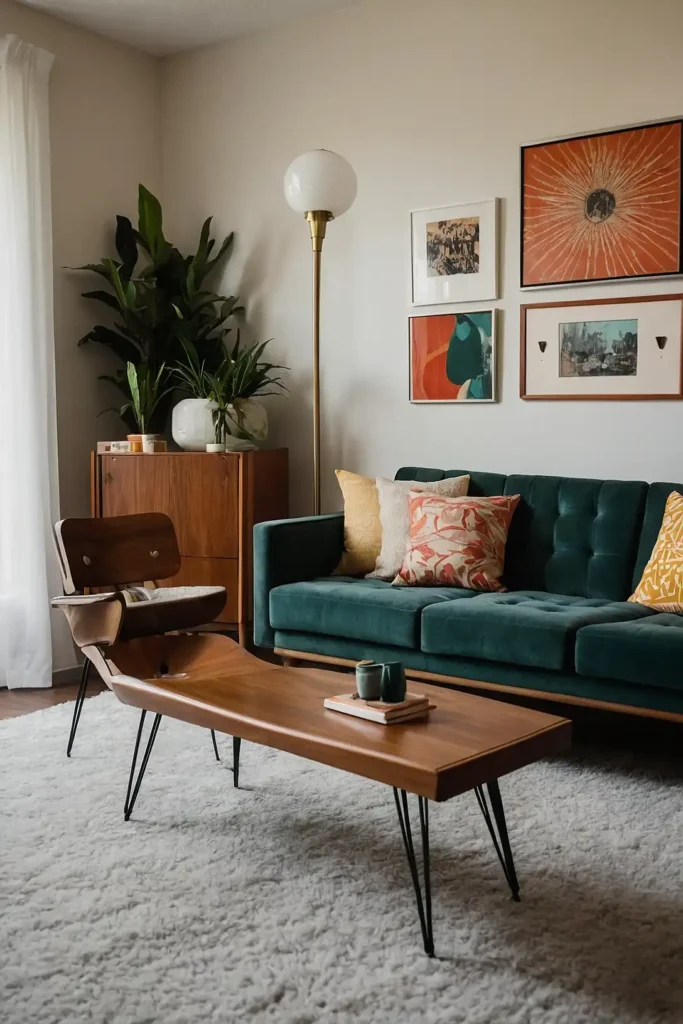
Choose tables, benches, and stands featuring slender hairpin legs for authentic midcentury aesthetics.
You add visual lightness while showcasing the era’s innovative furniture construction.
The thin metal legs create floating effects that make furniture appear less heavy.
This technique works especially well in smaller living rooms needing visual space.
Your hairpin leg pieces embody midcentury principles of minimal, functional design.
18: Sunken Living Room Areas
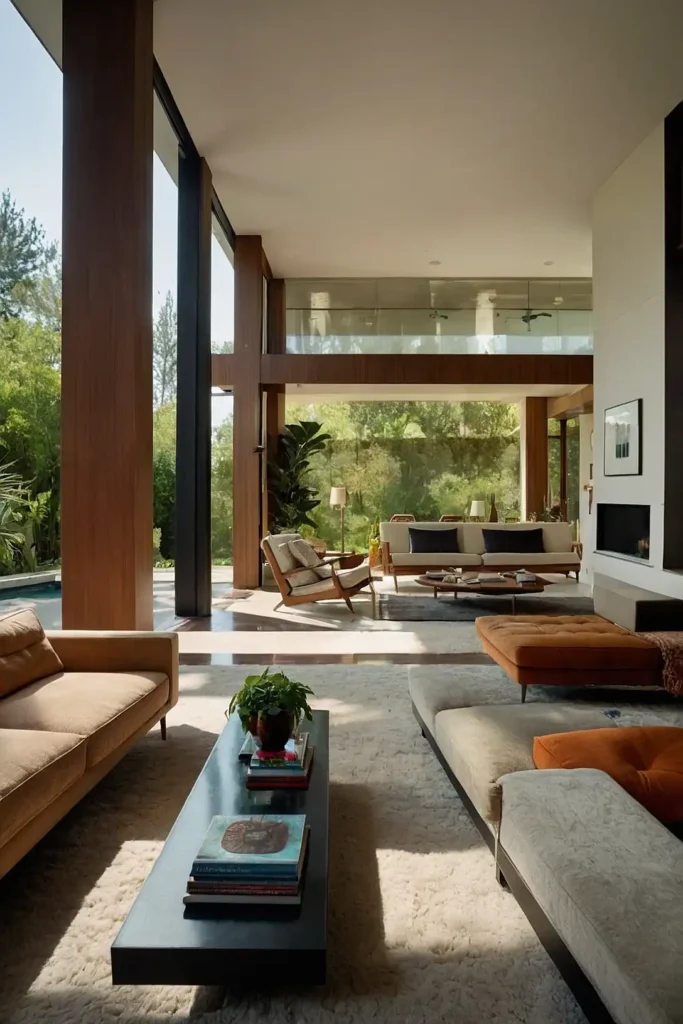
Create conversation pits or sunken seating areas that define intimate gathering spaces naturally.
You establish cozy zones while embracing distinctive midcentury architectural features.
Use area rugs, different flooring materials, or built-in seating to achieve sunken effects.
This approach encourages relaxed socializing and informal family interactions.
Your sunken area becomes a focal point that defines midcentury modern living.
19: Glass and Chrome Accessories

Include transparent and reflective accessories that enhance light and create visual lightness.
You add sophistication while maintaining the era’s preference for clean, uncluttered aesthetics.
Choose glass vases, chrome picture frames, and acrylic decorative objects strategically.
These materials complement wood and brass while adding contemporary sparkle.
Your glass and chrome pieces bring modern elegance without overwhelming natural materials.
20: Orange and Turquoise Accent Colors

Incorporate vibrant orange and turquoise as accent colors against neutral backgrounds for authentic period appeal.
You add energy while celebrating the era’s bold color preferences.
Use these colors in throw pillows, artwork, or ceramic accessories for flexibility.
The complementary combination creates visual excitement while maintaining sophisticated balance.
Your bold accents capture midcentury optimism and experimental color sensibilities perfectly.
21: Modular Furniture Systems
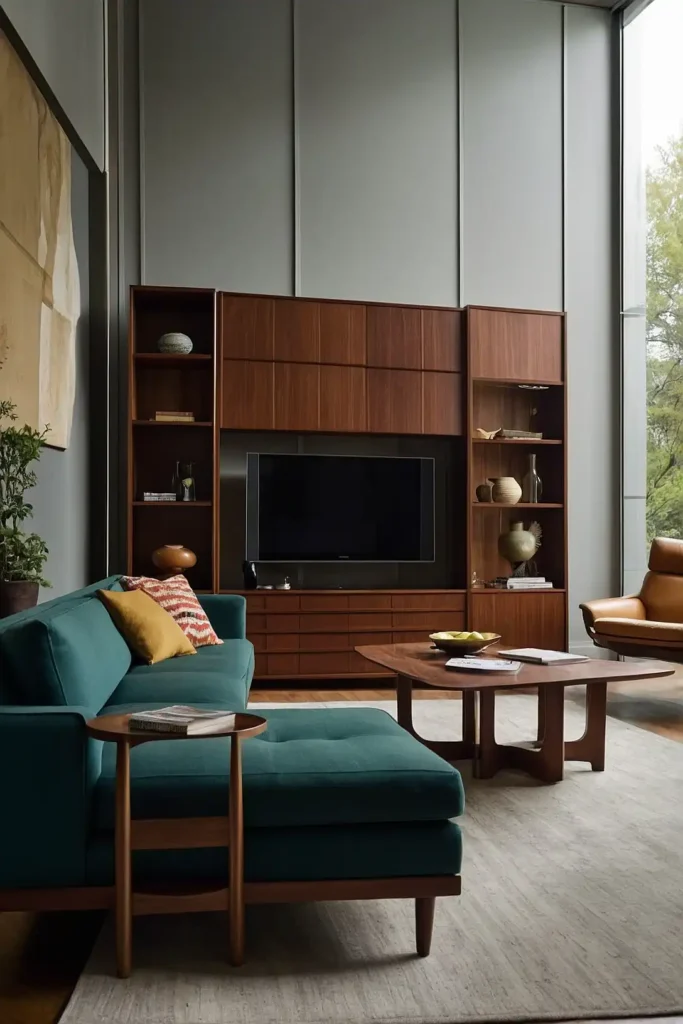
Choose sectional seating and storage pieces that reconfigure for different needs and occasions.
You embrace the era’s emphasis on flexibility and informal living arrangements.
Look for pieces that separate, stack, or rearrange easily for entertaining flexibility.
This approach accommodates changing family needs while maintaining design coherence.
Your modular pieces reflect midcentury values of adaptability and modern convenience.
22: Ceramic and Pottery Collections
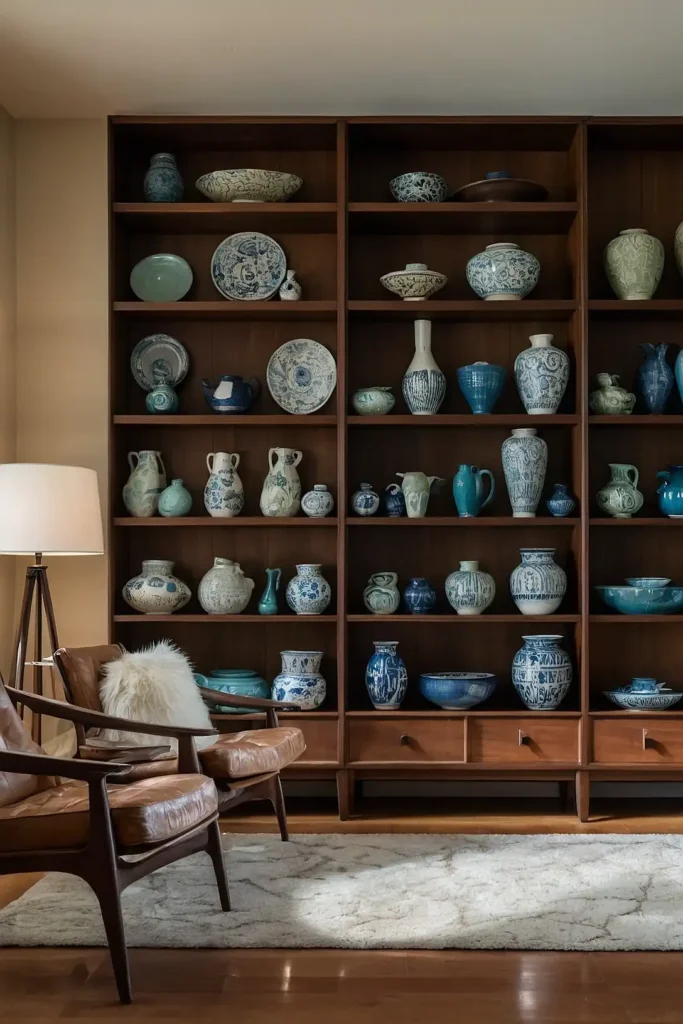
Display handcrafted ceramics in organic shapes and earth-tone glazes throughout living spaces.
You add artisanal elements while honoring the era’s appreciation for craft traditions.
Group pieces by color or form for visual impact on shelving and tables.
Choose vessels that complement your color scheme while adding textural interest.
Your ceramic collections bring human craftsmanship to machine-age modern interiors.
23: Sliding Glass Door Systems
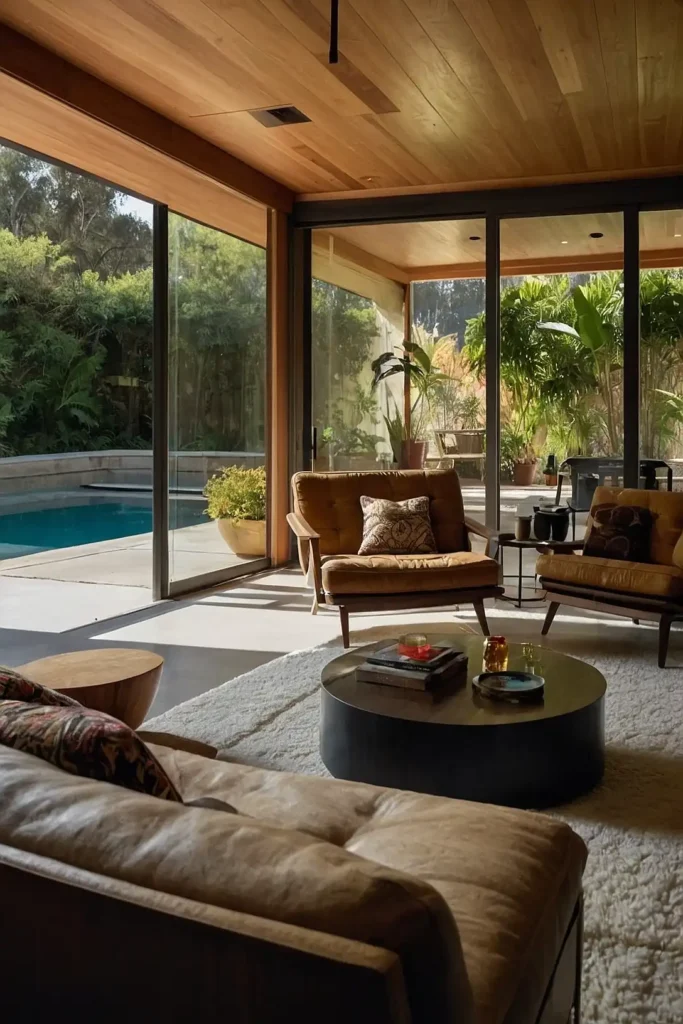
Install large sliding doors that connect indoor and outdoor living spaces seamlessly and naturally.
You maximize natural light while embracing midcentury indoor-outdoor living philosophies.
The clean hardware and expansive glass panels eliminate visual barriers between spaces.
This feature works especially well with patios, decks, or garden areas.
Your sliding doors embody midcentury principles of openness and natural connection.
24: Wire Frame Accent Chairs
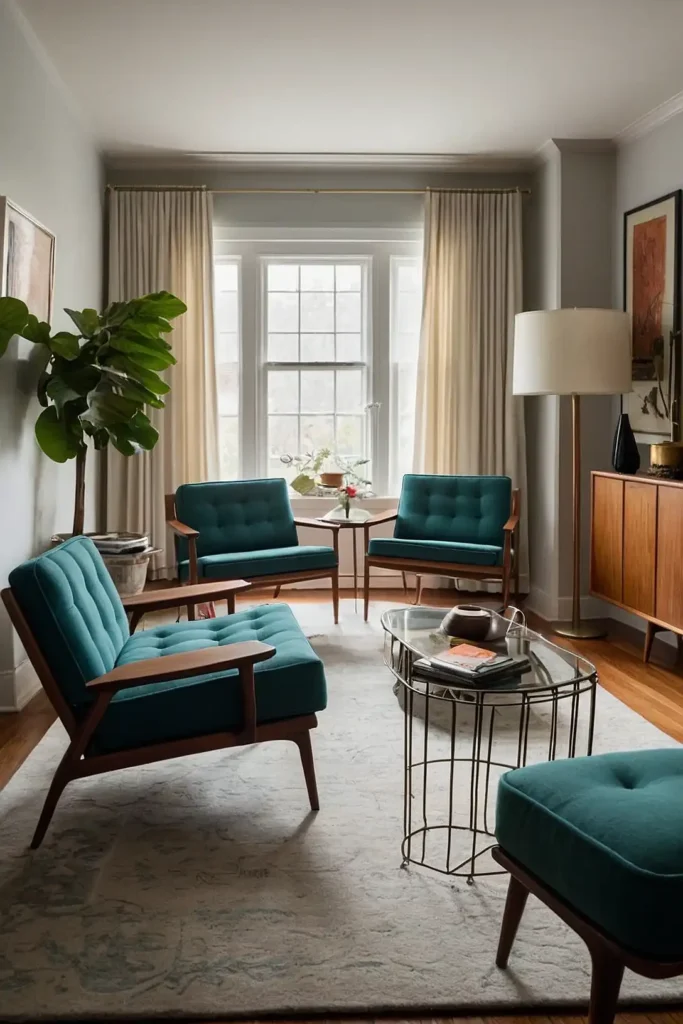
Include chairs featuring bent wire or metal rod construction for sculptural seating options.
You add artistic elements while showcasing the era’s experimental furniture materials.
Position wire chairs as accent pieces rather than primary seating for visual interest.
The transparent quality helps maintain open, airy feeling in smaller spaces.
Your wire chairs become functional art pieces that define midcentury innovation.
25: Exposed Beam Ceilings
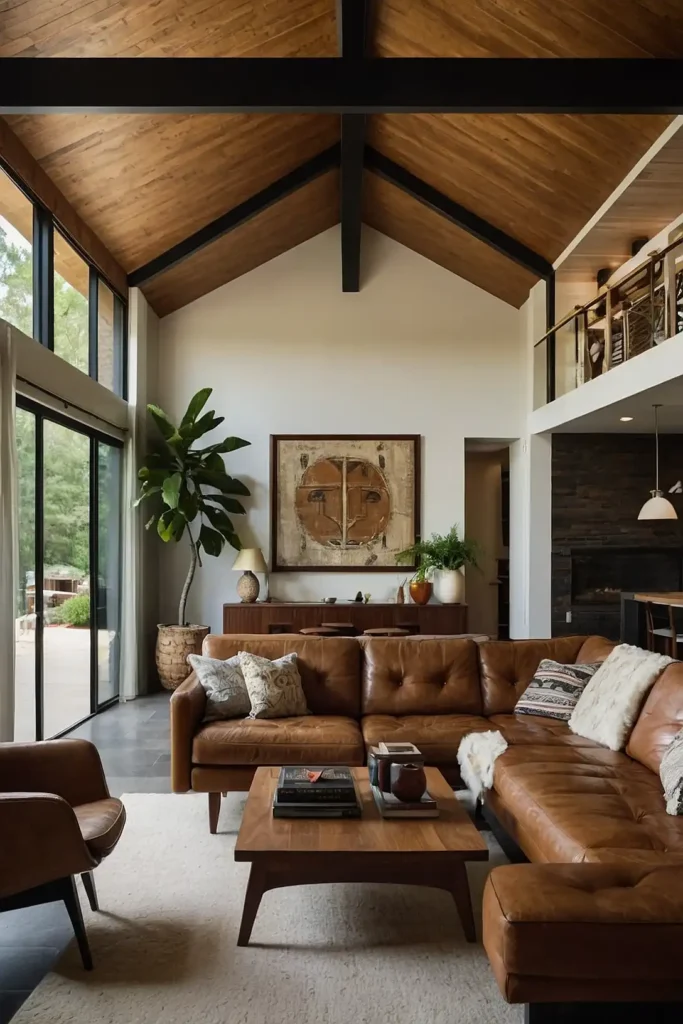
Highlight natural wood ceiling beams that add architectural character and warmth to spaces.
You showcase structural elements while connecting to the era’s material honesty principles.
Leave beams natural or stain them to complement furniture wood tones throughout rooms.
The horizontal lines create visual width while adding organic texture overhead.
Your exposed beams bring architectural authenticity to midcentury modern living rooms.
26: Curved Sectional Arrangements
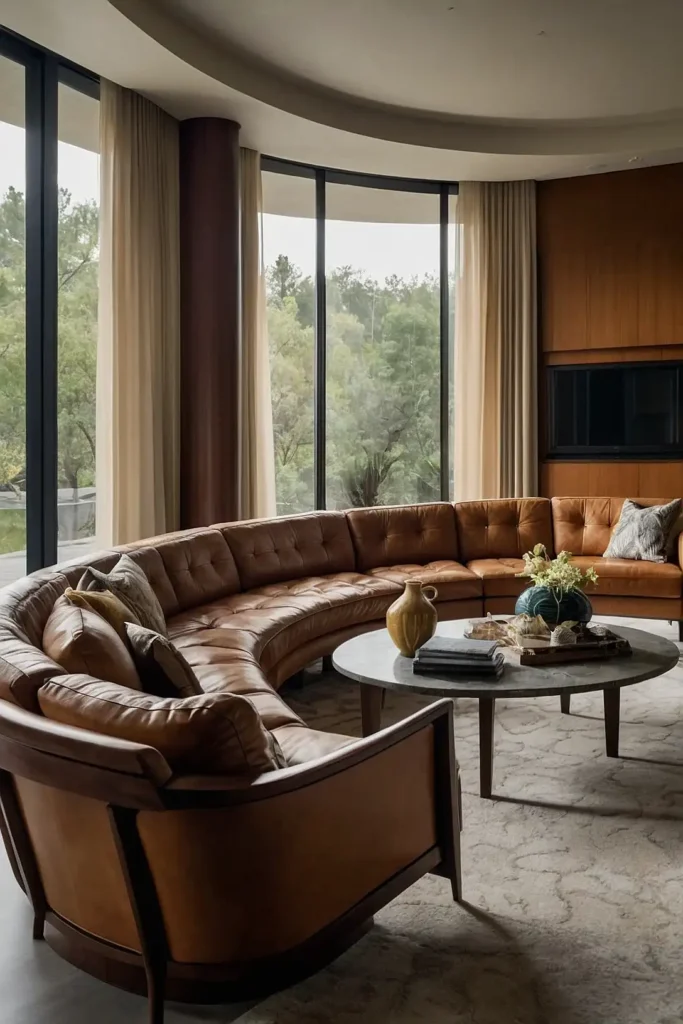
Arrange curved or angled sectional seating that follows organic lines rather than rigid geometry.
You create flowing conversation areas while softening angular architectural elements.
The curved arrangement encourages intimate socializing and relaxed family interactions naturally.
This approach works well in both large and small living spaces.
Your curved seating reflects midcentury embrace of both comfort and sculptural form.
27: Record Player and Music Centers

Create dedicated music areas featuring vintage record players and album storage for authentic period appeal.
You celebrate the era’s love for high-quality audio and music culture.
Include low credenzas for equipment and vinyl storage with easy access for regular use.
The music center becomes both functional and decorative room focal point.
Your music area captures midcentury lifestyle values of sophisticated home entertainment.
Conclusion
These midcentury modern ideas create living rooms that honor design history while meeting contemporary needs.
Your authentic touches bring timeless sophistication to modern homes.

